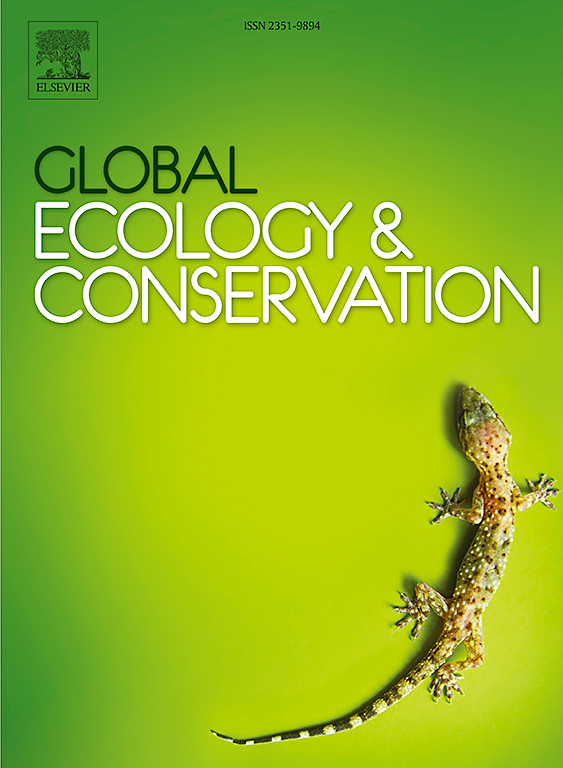Towards implementing workflows for essential biodiversity variables at a European scale
IF 3.4
2区 环境科学与生态学
Q1 BIODIVERSITY CONSERVATION
引用次数: 0
Abstract
Biodiversity is declining, prompting new multilateral treaties and environmental legislation. To track the progress of these efforts, a comprehensive monitoring network is essential. For the European Union (EU), the EuropaBON network has proposed a biodiversity observation network (BON) based on 84 Essential Biodiversity Variables (EBVs). These encompass species and habitats in the freshwater, marine, and terrestrial realms. Generating EBVs will require implementing workflows, including data collection, integration, and modelling. Here, we present the first conceptual representation of EBV workflows for guiding the future implementation of EBVs in a European BON based on insights from an EU-wide stakeholder consultation that engaged hundreds of experts in science, policy, and practice. Results suggest that implementing EBV workflows requires to incorporate advanced monitoring methods, enhance geographic, taxonomic, and temporal coverage, harmonize heterogeneous data, apply metadata standards, and develop new spatial models and quantitative indicators. Recommendations include enhancing monitoring techniques such as digital sensors, DNA-based methods and citizen science for species-focused EBVs, as well as satellite and aerial remote sensing for ecosystem-focused EBVs. For operationalizing a European BON, species-focused EBVs require better national, regional, and European data integration of different data types and data providers. In contrast, monitoring of ecosystem-focused EBVs would benefit from a centralized coordination of ground truth data collection and new Earth Observation products. The key components of the EBV workflows, along with the requirements and implementation needs identified here, together with emerging tools and projects, will help to shape the future implementation of EBV workflows at a European scale.
在欧洲范围内实施基本生物多样性变量的工作流程
生物多样性正在下降,催生了新的多边条约和环境立法。为了跟踪这些努力的进展,一个全面的监测网络是必不可少的。对于欧盟(EU), EuropaBON网络提出了一个基于84个生物多样性基本变量(ebv)的生物多样性观测网络(BON)。这些包括淡水、海洋和陆地领域的物种和栖息地。生成ebv需要实现工作流,包括数据收集、集成和建模。在这里,我们提出了EBV工作流程的第一个概念性表示,以指导欧洲BON中EBV的未来实施,该工作流程基于来自全欧盟利益相关者咨询的见解,该咨询涉及数百名科学、政策和实践专家。结果表明,实施EBV工作流需要采用先进的监测方法,增强地理、分类和时间覆盖,协调异构数据,应用元数据标准,开发新的空间模型和定量指标。建议包括加强以物种为重点的ebv的数字传感器、基于dna的方法和公民科学等监测技术,以及以生态系统为重点的ebv的卫星和航空遥感。为了实现欧洲BON的运作,以物种为重点的ebv需要更好地整合不同数据类型和数据提供者的国家、区域和欧洲数据。相比之下,以生态系统为重点的ebv监测将受益于地面真实数据收集和新的地球观测产品的集中协调。EBV工作流的关键组成部分,以及这里确定的需求和实现需求,以及新兴的工具和项目,将有助于在欧洲范围内塑造EBV工作流的未来实现。
本文章由计算机程序翻译,如有差异,请以英文原文为准。
求助全文
约1分钟内获得全文
求助全文
来源期刊

Global Ecology and Conservation
Agricultural and Biological Sciences-Ecology, Evolution, Behavior and Systematics
CiteScore
8.10
自引率
5.00%
发文量
346
审稿时长
83 days
期刊介绍:
Global Ecology and Conservation is a peer-reviewed, open-access journal covering all sub-disciplines of ecological and conservation science: from theory to practice, from molecules to ecosystems, from regional to global. The fields covered include: organismal, population, community, and ecosystem ecology; physiological, evolutionary, and behavioral ecology; and conservation science.
 求助内容:
求助内容: 应助结果提醒方式:
应助结果提醒方式:


